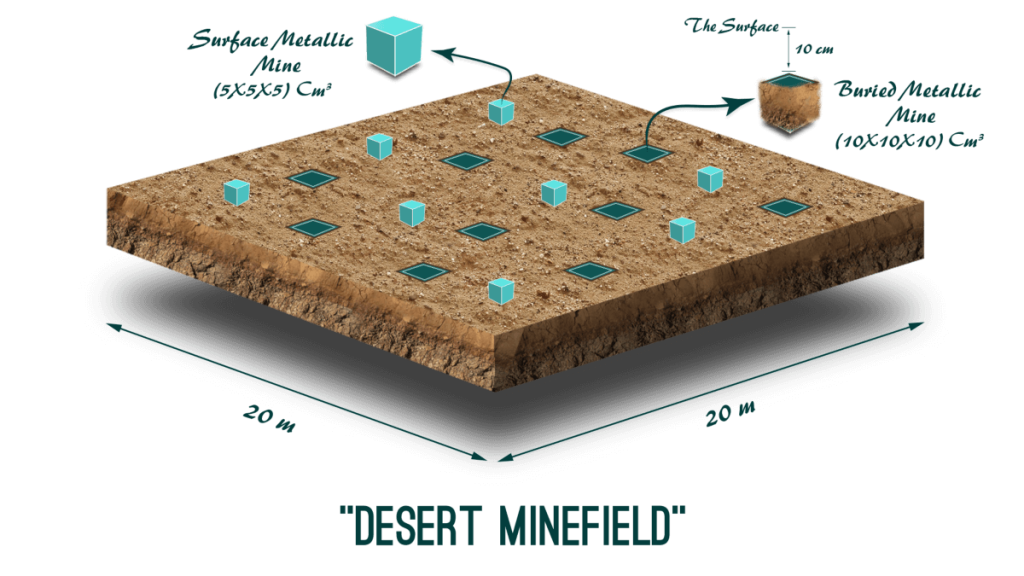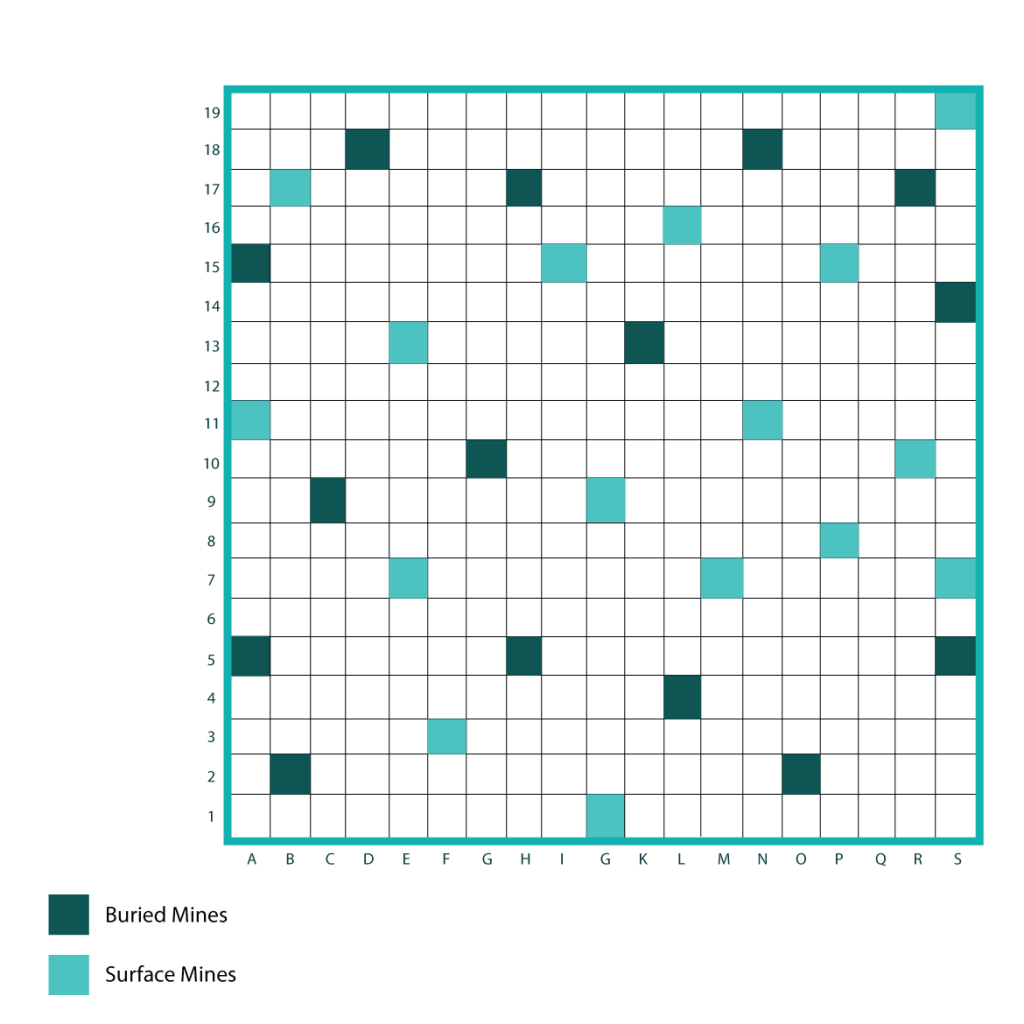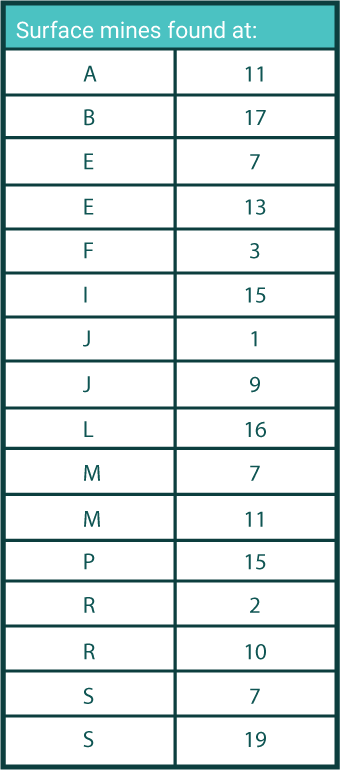Academia category will take part in the competition have to do these main following tasks in the arena:
- Minefield detection and making alarm for each detection.
- Collecting the surface mines (manually/automatically).
- Automatically mapping the location of detected mines.
The mission in details:
It is required from each participated team to build teleoperated or autonomous robot to detect the mines, which will be surface and buried metal mines, making alarm for each detection, collecting the surface mines in the container on the robot and creating an automatically map by the robot on it or outside the field.
Minefield
The competition environment will be an area with a size of 20m x 20m, delimited by four GPS coordinates. The competition area will be marked only by plastic tape for visualization purposes to stop the robots from going outside the competition area, there will not be any flags or lines in the arena. There will be no mines in a stripe of 0.5 m of terrain along the borders of the competition area. Most of the arena may be contain some of these; low grass with a few trees, some steep inclines, ditches, culverts and muddy water, or some sand, stones and as shown in the figures below.


Mines
Two different kinds of artificial mines are used in this competition:
Surface Mines: These mines are made from metallic cubes, with approximate dimensions of 5*5*5 cm3 (L*W*D) and labeled in black color. These mines are visible and are located on the surface of the competition area. These black metallic cubes are used to simulate above ground mines and unexploded ordnance (UXOs).
*Unexploded Ordnance is a piece of explosive ordnance or ammunition that has failed to function as intended. Although they have failed to function as intended, UXO can sometimes require only the slightest disturbance to detonate. UXOs vary greatly in size from hand grenades the size of an apple to large aircraft bombs.
The location of the surface mines will be changed every match.
Buried Mines: These mines are made from metallic cubes, with approximate dimensions of 10x10x10 cm3 (L*W*D). These mines are completely buried underground with maximum depth 10 cm. These buried metallic cubes mimic real anti-personnel (AP) blast mines. Real AP blast mines are deliberately designed to be small (typically 6-14 cm in diameter): this makes them cheaper and easier to store, carry and deploy. AP blast mines rely on the effect of explosive blast to damage the victim, and are designed to detonate when the victim steps on them. These mines are often buried in order to camouflage their presence.
Some landmines will be organized in a pattern for easier removal and accountability and others will be scattered randomly. The jury committee will know locations of each landmine.
The Robots
Each team must use a teleoperated or an autonomous robot per game. The robot has to be made by team members. Teleoperated robot must be operated remotely from a base station located outside the minefield.
The robot can be UGVs, UAVs with no limitations for size. Wireless controller based on ZigBee for example would be recommended to communicate the base station with the robot due to the large size of the field. In case of autonomous robots, all the actions of the robot must be completely autonomous without human intervention. Autonomous robot will be rewarded a 20% bonus over teleoperated robots. Careful attention must be paid to the robot locomotion systems, as the roughness of the terrain is very high. Both unmanned ground vehicles (UGVs) and unmanned aerial vehicles (UAVs) are allowed as illustrated in the figure below.

Unmanned ground vehicles can be wheeled, legged or hybrid.
Wheeled robots include but are not limited to differential drive, tricycle drive, Ackerman steering, synchro drive, omnidirectional drive, Multi-Degree-of-Freedom (MDOF) vehicles, MDOF vehicle with compliant linkage or tracked vehicles.
Legged robot can be uniped, biped, tripod, pentapod, quadruped or hexapod robot.
Any types of hybrid locomotion can also be used. Examples of hybrid locomotion include a vehicle equipped with tracks for fast locomotion, and legs for more difficult terrain or flippers with self-cleaning tracks or legged vehicles with driving wheels attached to the end of each leg.
UAV can be an alternative for the locomotion systems. As shown in above figure, UAVs can be classified into fixed wing, conventional helicopters and multi-rotor helicopters.
Fix wind UAVs are naturally stable platforms capable of long flight times and extreme range. However, they are difficult to coordinate with slower ground systems.
Conventional helicopters are common collective pitch model helicopters known for their excellent maneuverability and scalability. However they suffer from high level of complexity.
Quad-rotors have the ability to hover and there are naturally stable and durable. However, they have limited pay-load.
Ball-bots or UAVs that can land on a roving platform are also allowed.
Robot can also be an unmanned aerial vehicle or a quad-rotor.
Robot can be actuated using electric, pneumatic or hydraulic actuation system, Diesel/Petrol engine or using solar energy.
Mines detection
Each team can select their own set of sensors for detection of mines. When a robot detects a mine, it has to report autonomously this event using a light blinking signal or a warning siren.
Mines aggregation
According to the type of simulated anti-personal mines, the new challenge that it is required from each team to collect the detected surface mines in a box/container, which will be built on its own robot or be set in one corner of the arena. Therefore, each team can build their own mechanisms and mechanical and control system to collect the mines without any limitation on any system but take care on the safety rules. The team can collect mines manually or automatically by the robot with different scores.
Localization and mine map
Each robot has to provide automatically map of the detected mines when its competition time slot finishes. Depending on the mines location calculated and showing if, it is surface or buried mine. The map represents a 19m×19m area. Letters A to S and the Y coordinate of the map consists of numbers 1 to 19 show the X coordinate of the map. This mine map can be represented graphically or using vector format as shown in
The map may be shown using any display on the robot, on the laptop or other device outside the arena.
Each team can choose their own suitable sensors for localize the detected mines’ position and the suitable software for mapping creation.



Mission score
- 10 points for detecting every buried metallic mine.
- 5 points for detecting every surface metallic mine.
- 10 points for each correct surface mine collected automatically.
- 5 points for each correct surface mine collected manually.
- 10 points for correct defining every buried metallic mine location.
- 5 points for correct defining every surface metallic mine location.
- 30 points for complete surf of field if 80% of mines are detected correctly.
- -5 points for wrong surface mine detection
- -10 points for passing over a buried mine without detecting it.
- -5 points for touching a surface mine by the robot randomly.
- -3 points failure in producing a light signal and/or a siren for a detected mine.
- -2 points for every minute reset time.
Extra bonus
- The score will be multiplied by 1.4 for using Robot Operating System- ROS check it here.
- The score will be multiplied by 1.2 for using autonomous robot.
- The score will be multiplied by 1.2 for using multi robot system check it here.
- 20points bonus for live stream check it here.
*check the score sheet in Appendix F.

